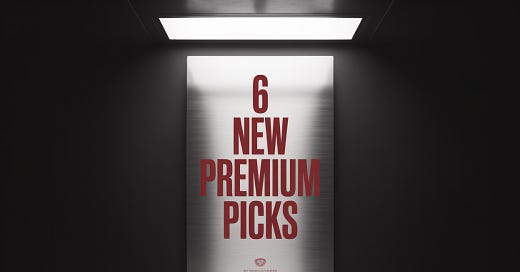Last Thursday's cash-secured puts are already up +2.7% in just seven days.
While most dividend strategies deliver around 0.75-1% quarterly, my picks have generated nearly three times that in a single week, with time decay continuing to work in our favor through expiration.
I'm back with 6 fresh premium opportunities that passed through my VADER screen this morning.
But first, let's see how our current positions are performing.
The actual scorecard from my May 1st positions:
Net +2.7 % of total premium in 7 days (typical target ≈ 1 %/month).
Out of 12 positions, we're seeing 9 winners and only 3 laggards.
More importantly, even the positions showing paper losses have substantial safety buffers (except PLTR, which we'll address shortly).
What exactly are you looking at here?
P/L per share: Simple—green numbers mean the position has gained value, red means it's currently underwater.
Buffer vs Breakeven: This is your safety margin—how far the stock can fall before you lose money at expiration. A 21% buffer on PFE means the stock can drop another 21% and we'd still break even.
This is why I emphasize position management over prediction.
Despite PLTR showing a 6% negative buffer (meaning it's fallen below our breakeven), our overall picks are still up 2.7% in just one week.
That's nearly triple what most income investors expect to make in a quarter—and we've barely started harvesting the time decay.
A detailed cheat sheet with my preferred management actions is included in the Multiplier Premium section that follows.
Strategy Refresher: Cash‑Secured Puts in plain English
This strategy boils down to one concept: getting paid to place limit orders on stocks you'd buy anyway.
How it works:
You sell a put contract, agreeing to buy 100 shares at the strike price
Your broker reserves the cash needed to buy those shares
You collect premium immediately
Only two possible outcomes:
Stock stays above strike → you keep 100% of premium
Stock drops below strike → you buy shares at an effective discount
Why it works: Time decay is relentless. Options lose value every day—like ice melting in the sun.
Most stocks spend 80-85% of days either moving sideways or moderately up/down. Only 2-5% of days see dramatic drops.
When you sell puts, those odds work in your favor.
How I Pick Winners:
I don't pick these trades by gut feeling.
I use my Volatility Arbitrage Dividend Enhancement Return algo - aka VADER.
Twice weekly, I screen 3,200+ stocks through 16 specific filters, sorting opportunities into three tiers:
Conservative: 5-6% yearly yield, minimal drama
Balanced: 7-10% yield, my personal sweet spot
Aggressive: 10-18% yield, for tactical traders
These exact picks hit Premium subscribers' inboxes every Thursday and Sunday—the same ones powering my family's retirement.
Disclaimer: The tables below show how I screen for income. They are not trade recommendations, signals, or financial advice. Use them as educational foundation only—back‑test, sanity‑check, and consult a licensed professional before risking a nickel.
Tier 1: Conservative Income
Ideal for: Retirement accounts, lower volatility goals, larger position sizes
Disney (DIS) – Sell the $85 put expiring 19 Sep 2025
Premium: $1.74 per share (that's $174 immediately in your pocket)
Capital required: $8,500 minus premium
Delta: -0.13 (only ~13% probability you'll own shares)
Annual return: 5.6% if it expires worthless
Why it works: Strike sits 16% below today's price at an 8-year support level
Risk management: Keep position ≤5% of portfolio; set alert at $80.75
My take: Disney's streaming losses are narrowing while parks continue delivering record revenue. The $85 strike sits where the stock bottomed during COVID—a price that already reflects catastrophic scenarios.
Exxon Mobil (XOM) – Sell the $85 put expiring 17 Oct 2025
Premium: $1.76 per share
Capital required: $8,500 minus premium
Delta: -0.12 (~12% chance of assignment)
Annual return: 4.7% if it expires worthless
Why it works: Strike sits $20 below current price in a multi-year value zone
Risk management: Limit to ≤5% of portfolio; set alert at $80.75
My take: With a 3.3% dividend yield and energy demand resilience, XOM at $85 would be a steal. The world still runs on oil, and Exxon's diversification into carbon capture provides a hedge against the energy transition.
Tier 2: Balanced Approach
Ideal for: Core portfolio positions, moderate risk tolerance
This is where I deploy most of my own cash. It balances meaningful income with quality businesses.
Keep reading with a 7-day free trial
Subscribe to The Multiplier to keep reading this post and get 7 days of free access to the full post archives.







